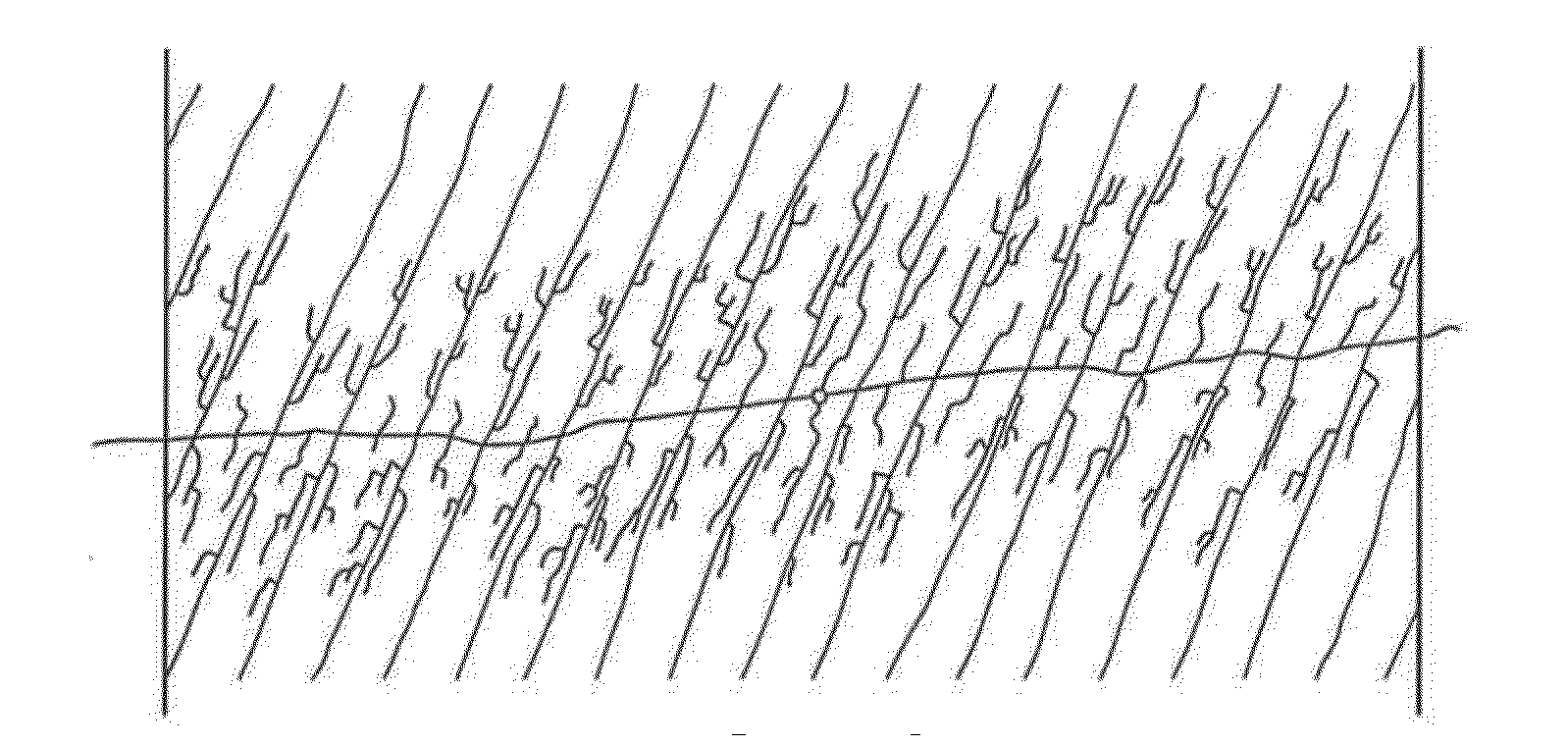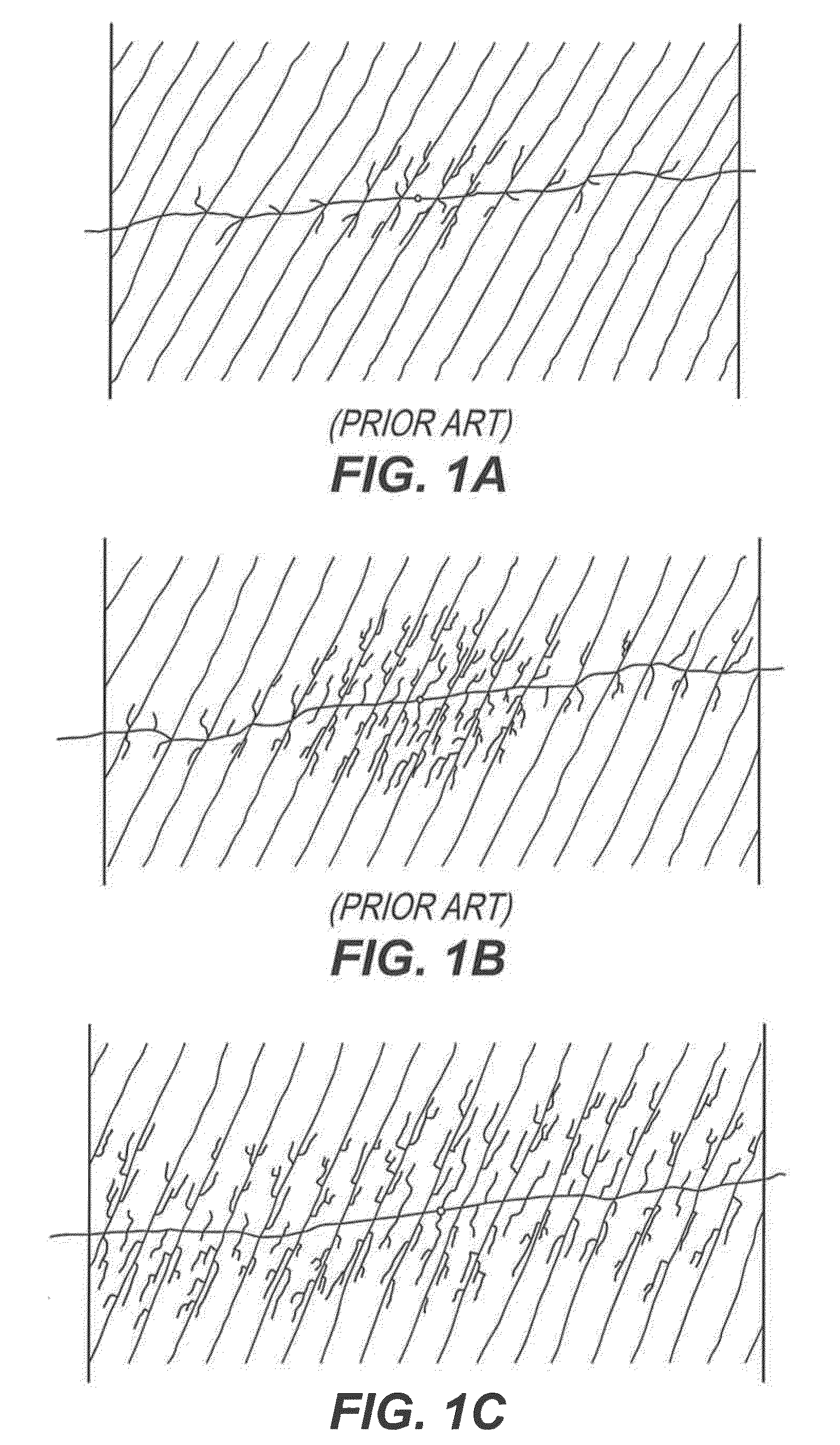Method of enhancing the complexity of a fracture network within a subterranean formation
- Summary
- Abstract
- Description
- Claims
- Application Information
AI Technical Summary
Benefits of technology
Problems solved by technology
Method used
Image
Examples
example 1
[0128]This Example demonstrates that the creation of fracture complexity has a strong relation with the type of fluid injected into a formation. Mancos and Eagle Ford shale cores with a dimension of 2″ diameter by 2″ length were tested. The shale cores, having a permeability of approximately 20 nDarcy, were cracked using the experimental illustrated in FIG. 8 wherein a hole of 0.25″ diam.×0.75″ length was drilled in one face of core 11 in fracturing cell 14. A 0.25″ outer diameter tube 13 was placed and fixed inside the hole at a depth of 0.25″ leaving an open hole section of 0.5″ in length. Fracturing fluid 21 in accumulator 12 was pumped into fracturing cell 14 through first inlet 16 at an injection rate up to 5 ml / min and a maximum injection pressure of 6000 psi using pump 10. The accumulator for the fluid held up to 250 ml. Pressure was introduced into fracture cell 14 through second inlet 18. Pressure was monitored with pressure transducer 20. Gas regulator 24 applied overburde...
example 2
[0130]The Mancos shale core of Example 1 was cracked using the experimental set-up illustrated in FIG. 8 and described above. Four fluids—3 wt. % KCl solution, hydraulic oil, linear polymer gel containing 35 lbs. of guar, and a crosslinked borate gel containing 35 lbs. of guar—were injected into four different cores with an injection rate of 5 ml / min. and the pressure drop was recorded as a function of time. As each fluid was injected through the core, the injection pressure was continuously increased and the breakdown pressure determined as the pressure when the shale broke.
[0131]FIG. 11 shows the viscosity of the four systems while FIG. 12 shows the breakdown pressure for the four fluids. The Figures illustrate that an increase in fluid viscosity increased the pressure needed to breakdown the formation. The results shown in FIG. 11 and FIG. 12 confirmed that breakdown pressure in shale formation has a strong relationship with the fracture fluid viscosity. A lower fluid viscosity w...
example 3
[0132]The experimental set-up illustrated in FIG. 8 and discussed in the Example above was equipped with a nitrogen cylinder having a pressure up to 2500 psi and which was connected to the inlet line to allow nitrogen injection. Two experiments were performed to crack each shale core. The first one included injection of a 3 wt. % KCl solution (representing a conventional water fracturing fluid system) while the second experiment included the injection of nitrogen as the fracturing fluid. The pressure drop was recorded as a function of time. As each fluid was injected through the core, the injection pressure was continuously increased until the shale broke at certain pressure (the breakdown pressure). An increase in the fluid viscosity increased the pressure needed to breakdown the formation. A single fracture was noted from use of the conventional fracturing fluid system. A complex fracture network was observed in all three cores tested with the nitrogen treatment. A clear single fr...
PUM
 Login to View More
Login to View More Abstract
Description
Claims
Application Information
 Login to View More
Login to View More - R&D
- Intellectual Property
- Life Sciences
- Materials
- Tech Scout
- Unparalleled Data Quality
- Higher Quality Content
- 60% Fewer Hallucinations
Browse by: Latest US Patents, China's latest patents, Technical Efficacy Thesaurus, Application Domain, Technology Topic, Popular Technical Reports.
© 2025 PatSnap. All rights reserved.Legal|Privacy policy|Modern Slavery Act Transparency Statement|Sitemap|About US| Contact US: help@patsnap.com



